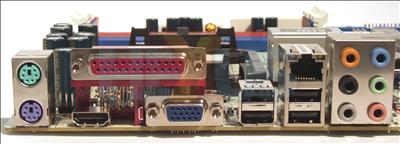Sapphire PI-AM2RS690MHD - layout and features
Sapphire had a long-standing relationship with ATI, including working on making reference designs for its chipsets - and now the relationship continues with AMD.
Given this level of co-operation, we have high hopes for the PI-AM2RS690MHD motherboard even if we aren't entirely sure how to pronounce its catchy model name.
The PI part of the title, for those who are interested, stands for PURE Innovation, so let's see if that's true.
Sapphire uses a white PCB. We're undecided whether or not this looks good but we know it gave us a powerful craving for Milky Bars.
While the basic component placement may look similar to that of the M2A-VM HDMI, there are some very pronounced differences.
As with the ASUS, both the northbridge and southbridge are passively-cooled, ensuring a zero-noise design.
The socket area sees the MOSFETs and capacitors pulled round towards the top of the board, rather than sitting between the CPU socket and the back-panel.
This also means that the ATX12V connector is further in, making it a little easier to cable.
Once again, clearance around the socket should be fine for most heatsinks. Sapphire has chosen to orientate the AM2 heatsink-retention bracket differently to ASUS, even though the socket faces the same way.The positioning of the memory-slots, floppy drive and ATX connector is similar to that of the M2A-VM HDMI. The location and quantity of the surrounding capacitors does differ but, from an end-users' perspective, they are functionally the same.
Around the southbridge is the same array of connectivity options for hard drives and opticals as on the M2A-VM HDMI - four SATA headers and a single IDE socket.
However, unlike with the ASUS, the IDE connector is set in from the side of the board and facing upwards. This makes room for the front-panel headers. These are lined up in a row and, refreshingly, are very clearly labelled - the black-on-white text proving especially easy to read. A small touch but we like it.
Sapphire locates the two PCIe slots together, rather than separated by the two standard PCI slots. So, unlike with the ASUS, if you fit a two-slot PEG card you'll have no further PCIe expansion possibilities - only a pair of standard PCI slots.
Which layout you prefer is, to a degree, a matter of component choice. The Sapphire's is more conventionally useful, the ASUS's a little more forward-thinking.
As the number of PCIe 1x cards coming to market increases, ASUS's arrangement looks the better of the two but if you have standard PCI cards you want to use, you'll favour the Sapphire.
[advert]The most obvious difference on the back-panel is the swapping of the dual-link DVI port for an HDMI output.
This means that the Sapphire instantly becomes more attractive for installations in half-height HTPC cases.
In addition, although the FireWire port has also gone, the audio block is a six-socket affair with inputs as well as a eight-channel output. But, there's still no optical or coaxial S/PDIF built into the back-panel.
However, since audio can also be transmitted via HDMI - and is included in the half-height form factor of the Sapphire - this omission is a little more forgivable. Also, and unlike ASUS, Sapphire has included an audio CODEC capable of Dolby Digital Live output - Realtek's ALC882D - and that's a bonus.
Ideally we'd have liked to have seen both boards lose the D-Sub connector from the back-panel and instead fit DVI-I and HDMI outputs. This would have allowed an analogue output through the DVI-I, using a DVI adaptor if necessary, and negated the need for a separate card for outputs at all.
Summary
From a functional standpoint, the layout of the Sapphire is very similar to that of the ASUS. There are no glaring layout issues and the main differences come down to the back-panel.
Neither board is perfect but each is a competent design.















